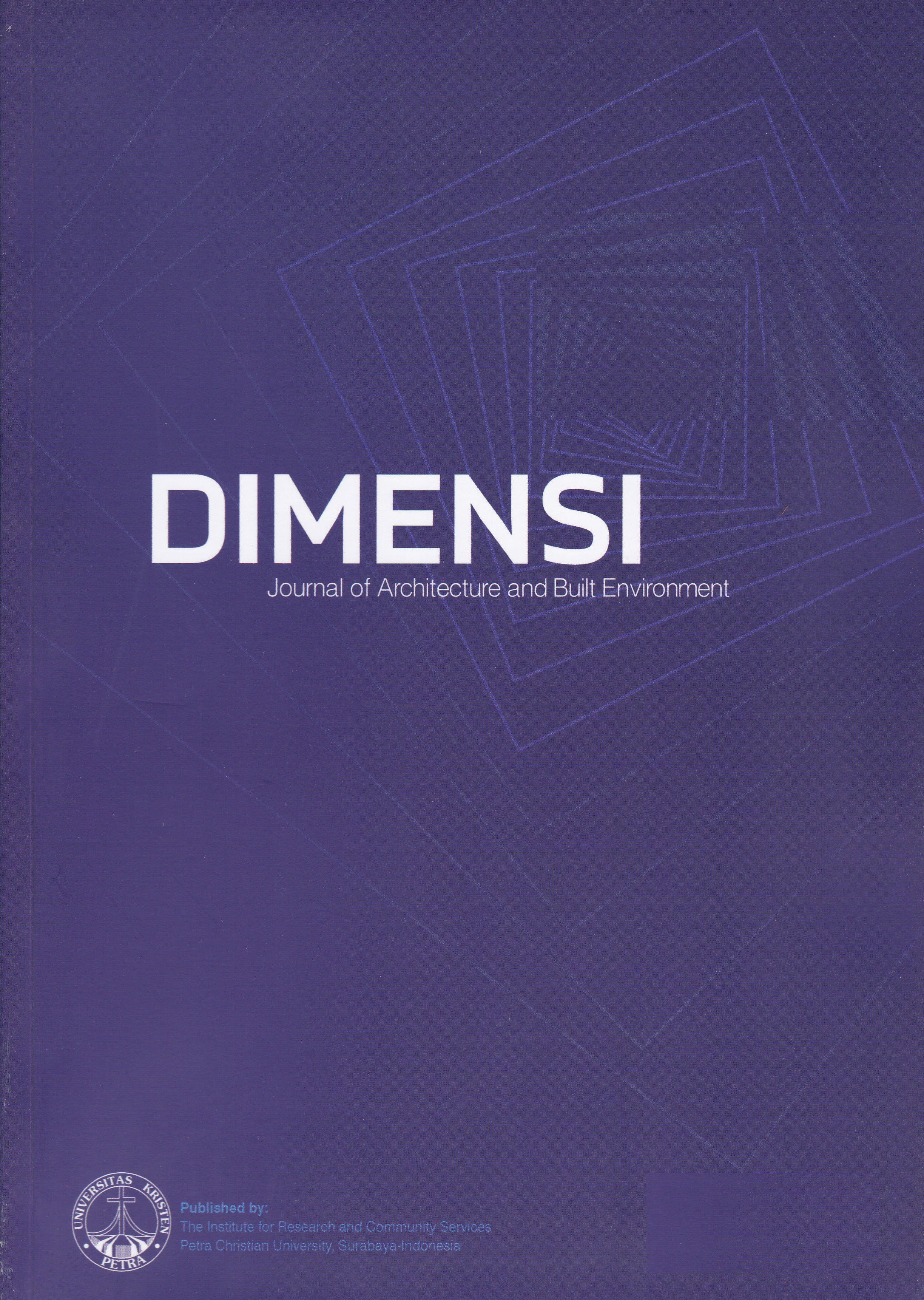Housing Attribute Preferences in Bandung City
A Comparison Between Generation X, Y, Z
DOI:
https://doi.org/10.9744/dimensi.51.1.8-16Keywords:
housing preference, principal component analysis, factor analysis, analysis of varianceAbstract
Each generation encounters distinct social, economic, cultural, and technological contexts specific to their era. Moreover, their lifestyles vary, resulting in disparate housing preferences. This study analyzes five housing attribute preferences of Generation X, Generation Y, and Generation Z: Economic attribute, location and accessibility attribute, physical attribute, environment attribute, and social attribute. The research uses a stated preference approach. The study uses a mixed method and a stated preference approach while collecting data by online questionnaire. Three analytical techniques are employed in this research: correspondence analysis to identify differences in dwelling type preferences among generations, PCA and FA to identify the underlying housing attribute influencing housing preferences, and ANOVA to analyze housing attribute dimensions with significant differences among generations. The analysis result reveals that each generation tends to prefer Landed Housing. The housing attribute dimensions that are the main priority among generations are Utilities, Infrastructure, and Environmental Quality. Meanwhile, significant differences in housing preferences between Generation X, Generation Y, and Generation Z are found in the space comfort and social interaction dimensions.
Downloads
References
Andoni, H., & Kusuma, H. E. (2016). Preferensi hunian yang ideal bagi pekerja dan mahasiswa pada kelompok umur dewasa awal/early adulthood. Prosiding Temu Ilmiah IPLBI, April 2017, 129–134.
Canter, D. V. (1974). Psychology for Architects. Applied science publ. https://lib.ugent.be/catalog/rug01:000026627
Creswell, W. J., & Creswell, J. D. (2018). Research design: Qualitative, quantitative adn mixed methods approaches. In Journal of Chemical Information and Modeling (Fifth Edit), 53(9). SAGE Publications, Inc.
Doxiadis, C. A. (1970). Ekistics, the science of human settlements. Scince, 393–404.
Dwidienawati, D., & Gandasari, D. (2018). Memahani generasi z Indonesia. International Journal of Engineering and Technology(UAE), 7(3), 245–252.
Ekananda, A. N., & Marcillia, S. R. (2019). Preferensi atribut fisik hunian generasi y dan z di Yogyakarta. Seminar on Architecture Research & Technology, 4(1), 327–335.
Hurtubia, R., Gallay, O., & Bierlaire, M. (2010). Attributes of households, locations and real-estate markets for land use modeling. SustainCity, 1–27. http://transp-or.epfl.ch/documents/technicalReports/sustaincity_WP2_7.pdf
Ismail, H., & Mohamed Shaari, S. (2020). The location, house, or neighbourhood choice preferences among Malaysian housing generations. Journal of Surveying, Construction & Property, 11(2), 64–74. https://doi.org/10.22452/jscp.sp2020no1.6
Jacobus, C. J. (2010). Real Estate Principles : Eleventh Edition. Cengage Learning.
Jansen, S. J. T., Coolen, H. C. C. H., & Goetgeluk, R. W. (2011). The Measurement and Analysis of Housing Preference and Choice. Springer. https://doi.org/10.1007/978-90-481-8894-9
Kaiser, H. F. (1958). The varimax criterion for analytic rotation in factor analysis. Psychometrika, 23(3), 187–200. https://doi.org/10.1007/BF02289233
Kaiser, H. F. (1960). The application of electronic computers to factor analysis. Educational and Psychological Measurement, 20(1), 141–151. https://doi.org/10.1177/001316446002000116
Lachman, M. L., & Brett, D. L. (2015). Gen Y and housing : what they want and where they want it. the Urban Land Institute.
Louvierè, J., & Timmermans, H. (1990). Stated preference and choice models applied to recreation research: A review. Leisure Sciences, 12(1), 9–32. https://doi.org/10.1080/01490409009513087
Maslow, A. H. (1954). Motivation and Personality. Harper & Row,Publishers, Inc. https://doi.org/10.4135/9781446221815.n7
Moghimi, V., & Jusan, M. (2015). Priority of structural housing attribute preferences: identifying customer perception. International Journal of Housing Markets and Analysis, 8(1), 36–52.
Nadiya, E. (2017). Studi preferensi generasi y dalam memilih hunian di Jakarta Barat. Jurnal Muara Ilmu Ekonomi Dan Bisnis, 1(1), 145. https://doi.org/10.24912/jmieb.v1i1.417
Pratama, F. A., & Idajati, H. (2022). Preferensi hunian generasi z berdasarkan faktor demografi yang berpengaruh (studi kasus : Kota Surabaya). Jurnal Teknik ITS, 11(2). https://doi.org/10.12962/j23373539.v11i2.85048
Puspitasari, D., Adianto, J., & Khoirunurrofik, K. (2022). Preferensi hunian di perkotaan pada generasi y di Kota Bekasi. Jurnal Pembangunan Wilayah dan Kota, 18(1), 54–65. https://doi.org/10.14710/pwk.v18i1.37176
Putra, Y. S. (2016). Theoritical review : Teori perbedaan generasi. Among Makarti, 9(18), 123–134.
Ramadhani, V. M., Faqih, M., & Setijanti, P. (2021). Preferensi pilihan jenis hunian berdasarkan perilaku belanja generasi z. Pawon: Jurnal Arsitektur, 5(2), 223–238. https://doi.org/10.36040/pawon.v5i2.3672
Rapoport, A. (1969). House Form and Society (P. L. Wagner (ed.)). Prentice-Hall, Inc. Englewood Cliffs.
Stillman, D., & Stillman, J. (2017). Gen Z Work: How the Next Generation Is Transforming the Workplace. Harper Business.
Syafrina, A., Tampubolon, A. C., Suhendri, Hasriyanti, N., & Kusuma, H. E. (2018). Preferensi masyarakat tentang lingkungan perumahan yang ingin ditinggali. Review of Urbanism and Architectural Studies, 16(1), 32–45. https://doi.org/10.21776/ub.ruas.2018.016.01.3
Tan, T. H. (2012). Meeting first-time buyers’ housing needs and preferences in greater Kuala Lumpur. Cities, 29(6), 389–396. https://doi.org/10.1016/j.cities.2011.11.016
Tan, T. H., & Khong, K. W. (2012). Between homeownership motivation and housing satisfaction. International Journal of Economic and Management, 6(1), 1–12.
Tang, A., Kusuma, H. E., & Riska, A. S. (2022a). Hubungan kausal antara 14 faktor preferensi generasi y dan z dalam memilih jenis hunian. Arsitektura : Jurnal Ilmiah Arsitektur dan Lingkungan Binaan, 20(1), 77–88.
Tang, A., Kusuma, H. E., & Riska, A. S. (2022b). Preferensi dalam memilih hunian menapak dan vertikal oleh generasi y dan z di Indonesia. Review of Urbanism and Architectural Studies, 20(1), 87–97. https://doi.org/10.21776/ub.ruas.2022.020.01.9
Wang, D., & Li, S. M. (2006). Socio-economic differentials and stated housing preferences in Guangzhou, China. Habitat International, 30(2), 305–326. https://doi.org/10.1016/j.habitatint.2004.02.009
Downloads
Published
How to Cite
Issue
Section
License
Authors who publish with this journal agree to the following terms:
- Authors retain copyright and grant the journal right of first publication with the work simultaneously licensed under a Creative Commons Attribution License that allows others to share the work with an acknowledgement of the work's authorship and initial publication in this journal.
- Authors are able to enter into separate, additional contractual arrangements for the non-exclusive distribution of the journal's published version of the work (e.g., post it to an institutional repository or publish it in a book), with an acknowledgement of its initial publication in this journal.
- Authors are permitted and encouraged to post their work online (e.g., in institutional repositories or on their website) prior to and during the submission process, as it can lead to productive exchanges, as well as earlier and greater citation of published work (See The Effect of Open Access).



















